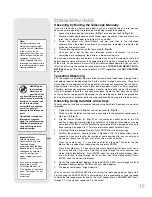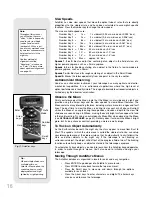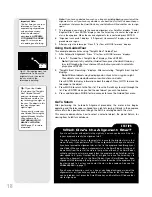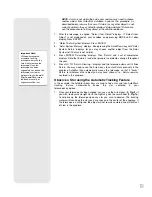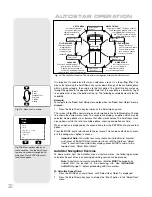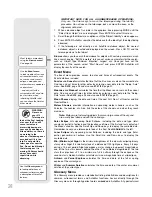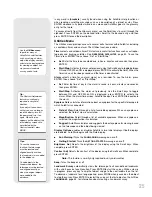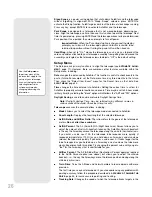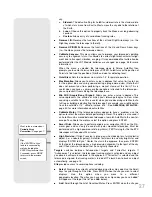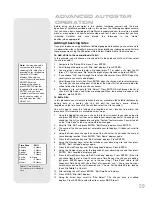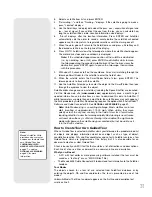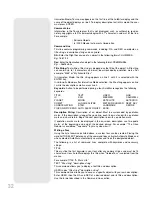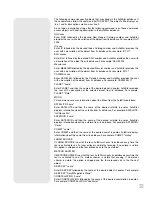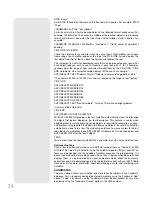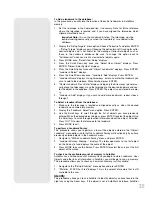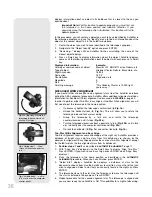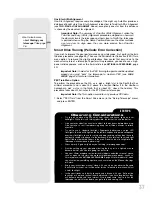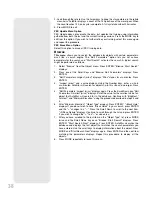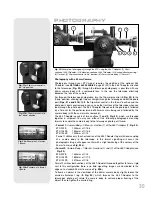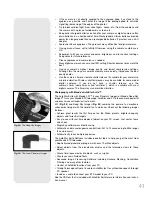
26
Sleep Scope is a power saving option that shuts down AutoStar and the telescope
without forgetting its alignment. With "Sleep Scope" selected, press ENTER to
activate the Sleep function. AutoStar goes dark, but the internal clock keeps running.
Press any key, except ENTER, to re-activate AutoStar and the telescope.
Park Scope is designed for a telescope that is not moved between observing ses-
sions. Align the telescope one time, then use this function to park the telescope. Next
time it is powered up, pressing ENTER and the telescope moves to its pre-determined
Park position. Once parked, the screen prompts to turn off power.
Important Note: When the "Park Scope" option is chosen and the display
prompts you to turn off the telescope's power, AutoStar is unable to be
returned to operation without turning the power off and then back on.
Cord Wrap, when set to "On," moves the telescope in such a way as to prevent the
cords and cables attached to your telescope assembly from getting wound around the
assembly and tangled as the telescope slews to objects. "Off" is the default setting.
Setup Menu
The Setup menu’s primary function is to align the telescope (see
AUTOMATIC ALIGN-
MENT
, page 17). However, there are numerous other features available within the
Setup menu, including:
Date changes the date used by AutoStar. This function is useful to check events in the
past or future. For example, set the Date menu for a day three months in the future.
Then check the "Select Item: Event" menu for the Sunset time on that date. See
EVENT MENU
, page 24.
Time changes the time entered into AutoStar. Setting the correct time is critical for
AutoStar to properly calculate locations and events. Time may be set to 24-hour mode
(military time) by selecting the "blank" option which follows the "AM" and "PM" options.
Daylight Saving is used to enable or disable Daylight Savings time.
Note: Daylight Savings Time may be referred to by different names in
various areas of the world. Check local time to verify.
Telescope accesses the several options, including:
J
Model: Allows you to select the telescope model connected to AutoStar.
J
Focal Length: Displays the focal length of the selected telescope.
J
Az/RA Ratio and Alt/Dec Ratio: The ratios refers to the gears of the telescope's
motors.
Do not alter these numbers.
J
Az/RA Percent: The Az (Azimuth)/RA (Right Ascension) Percent allows you to
adjust the amount of azimuth backlash taken out by AutoStar. Azimuth backlash
is the way the Arrow keys move the telescope along the azimuth (horizontal) axis.
If you enter a value near 100, the telescope tube responds more quickly (it
responds immediately at 100%) as you hold down an Arrow key and also slews
(moves) the tube more quickly. If you enter a value near 0, it takes longer for the
tube to respond as you hold down an Arrow key and also slews the tube more
slowly. Experiment with this option. Try changing the percent value until you get a
"feel" for the Arrow keys that is comfortable for you.
J
Alt/Dec Percent: The Alt (Altitude)/Dec (Declination) Percent operates identical
to the Az/RA Percent option (see above), but allows you to adjust the altitude
backlash, i.e., the way the Arrow keys move the telescope when moving along the
altitude (vertical) axis.
J
Train Drive: Trains the Altitude and Azimuth motors to locate objects with more
precision.
The first time you use your telescope or if you are experiencing any problems with
pointing accuracy, follow the procedure described in
APPENDIX C: TRAINING THE
DRIVE
, page 55, to insure accurate pointing and tracking.
J
Tracking Rate: Changes the speed at which the telescope tracks targets in the
Use the
Setup menu
to perform many of the
features that apply to the
set up of your telescope,
such as training the drive,
selecting terrestrial or
astronomical modes,
changing observing site
information.
Summary of Contents for ETX Premier
Page 1: ...Instruction Manual ETX Premier Edition Telescope Series AutoStar LNT SmartFinder ...
Page 2: ......
Page 59: ......




